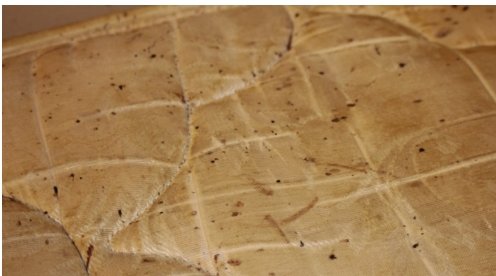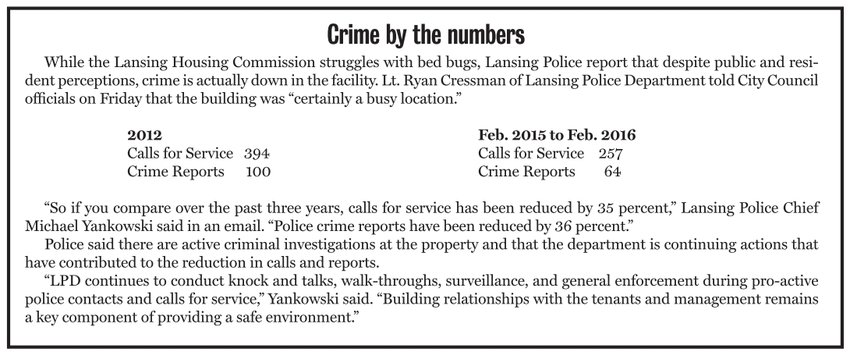
Late last year, the resident who had noticed red, itchy dots on his skin woke up one night to discover tiny bugs attached to his skin, feasting on his blood. He got out of bed and quickly identified the culprits: bedbugs.
“I knew what they were,” the resident, whom City Pulse is not identifying because he fears retribution from management, said. “I told them I looked them up on Google.”
The man lives at 3200 South Washington Ave. — a Lansing Housing Commission facility known as South Washington Park Apartments. The five-story, 190 apartment facility has been dubbed “the Tower of Terror” by some residents and has been plagued with crime, loitering, human feces and urine in public areas, accumulated garbage and, since 2012, bedbugs.
It’s not an isolated incident. Bedbugs have seen a resurgence not only in public housing and multi-family housing facilities, but in five-star hotels, libraries and beyond. An adult bedbug lives for six to 12 months, taking 10- to 15-minute blood meals off of warm blooded hosts — like humans — a couple of times a week, the Centers for disease Control reports. An adult female bedbug lays five eggs a day for her entire life.

Eradication efforts require vigilance and cooperation. “We are taking care of bedbugs as the residents let us know,” Tony Baltimore, the LHC chairman, told the Lansing City Council Committee on Public Safety on Friday.
The resident does not feel the commission has moved fast enough; his apartment still has not been treated for the bedbugs. An inspection did not occur until the end of January, and a treatment was not scheduled until mid-February. That treatment has been delayed by the resident in order to comply with the commission’s directives to move all belongings away from the walls and into the center of the room, and to launder and bag clothing and bedding.
LHC officials declined to provide City Pulse a timeline for addressing identified bedbug infestations. Patricia Baines- Lake, its executive director, was unable to identify the number of units infested or treated each year. But she added that staff are supposed to investigate then call in a contractor to inspect and treat infested units.
Baines-Lake said the facility is inspected annually using a dog trained to sniff out the bugs. In addition, the common areas are treated with bedbug-killing chemicals monthly, and the facility responds to resident complaints about the bugs.
Julie Powers, executive director of the Greater Lansing Housing Coalition, which provides housing and case management services to formerly homeless people with severe mental illness, said she is sympathetic to LHC’s struggle with bedbugs.
“They’re vile,” she said of the bugs. “They’re just nasty and very, very hard to treat.”
The bugs can be transported from one infested area to another on a human being’s clothing or bedding. The bugs can also spread out in a multi-unit building through electrical lines and infest adjoining units on either side, as well as above and below.
Powers said her organization is “extremely aggressive” in addressing bedbugs when they appear and regularly inspects for them.
“You can’t suck it up and wait on these suckers,” she said.
At South Washington Park Apartments, LHC then pays Eradico to treat the infested unit and adjoining ones as well. Baines-Lake told the City Council committee that it costs $200 to treat an apartment with chemicals, which may have a limited impact on infestations, and $800 to heat-treat a unit. Heat-treating requires the unit to be super-heated to 170 degrees, which kills all life stages of the bugs, from eggs to adulthood.

Relying on residents to report infestations — which Baines-Lake and Baltimore both acknowledged was something residents can feel self-conscious about — does not match with best practices recommended by a 2010 study funded by the Environmental Protection Agency and published by the National Center for Health Housing. It calls for monthly inspections of all units during infestations and quarterly inspections once the problem has been controlled.
“Residents with bedbugs can feel isolated,” Baines-Lake said. When a unit is confirmed to be infested, residents are advised not to visit friends or relatives, increasing the isolation. The reason behind the recommendation is that people can transport bedbugs. So while a unit at the facility might be successfully treated, if the infestation has been spread to outside locations, it can be brought back into the facility.
LHC officials acknowledge money is a barrier to addressing the ongoing crisis for both residents and the organization. Residents are expected to launder all their clothing and bedding, a potentially expensive proposition for people living on fixed income disability payments or social security. LHC does offer to refund residents for the cost of laundering, but that offer is not included in the letters about the problem sent to residents.
To reduce some of the costs of bedbug control and eradication, the commission is preparing to spend $1,800 to purchase a heat machine to use, significantly reducing the costs associated with control of the blood sucking bugs.

Support City Pulse - Donate Today!
Comments
No comments on this item Please log in to comment by clicking here